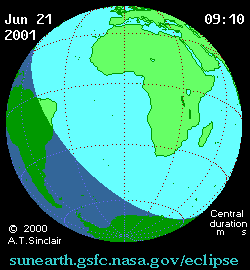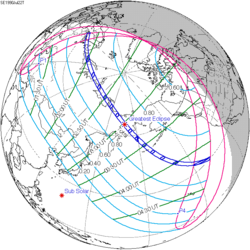Top Qs
Timeline
Chat
Perspective
Solar eclipse of June 21, 2001
Total eclipse From Wikipedia, the free encyclopedia
Remove ads
A total solar eclipse occurred at the Moon's ascending node of orbit on Thursday, June 21, 2001,[1] with a magnitude of 1.0495. It was the first solar eclipse of the 21st century. A solar eclipse occurs when the Moon passes between Earth and the Sun, thereby totally or partly obscuring the image of the Sun for a viewer on Earth. A total solar eclipse occurs when the Moon's apparent diameter is larger than the Sun's, blocking all direct sunlight, turning day into darkness. Totality occurs in a narrow path across Earth's surface, with the partial solar eclipse visible over a surrounding region thousands of kilometres wide. Occurring about 2.25 days before perigee (on June 23, 2001, at 18:20 UTC), the Moon's apparent diameter was larger.[2]
Many people traveled to Africa to watch the eclipse;[3][4][5] the Daily Telegraph reported that "while some tribesmen watch a celestial crocodile eating the sun, the modern African will be counting the cash brought in by thousands of visitors".[6]
Remove ads
Visibility
It was visible from a narrow corridor in the southern Atlantic Ocean and southern Africa, including Angola, Zambia, Zimbabwe, Mozambique, the southern tip of Malawi, and Madagascar. A partial eclipse was seen from the much broader path of the Moon's penumbra, including eastern South America and most of Africa.
Observations
Summarize
Perspective

Within the path of totality, Angola got the best conditions with the highest solar zenith angle, longest duration and largest chance of clear weather. Sumbe, capital of Cuanza Sul Province, where the path first touched land, was the best in Angola with 4 minutes and 34 seconds of totality. However, the Angolan Civil War[7] prevented many from traveling to the county, and only about 500 people observed the eclipse there. Besides tourists, there were also scientists from the United States, France, Brazil, South Africa, the Czech Republic, Portugal and Hungary.[8]
Zambia, though inferior to its neighbouring country Angola in the chance of clear weather, attracted many scientists and tourists due to its stable political situation and also the fact that its capital city Lusaka was also located within the path of totality.[7] The Zambian government made it a national holiday with one day off, and ZamPost also issues special postage stamps and first-day covers.[9] Scientists from the United States, the United Kingdom, Germany, Japan, South Korea and China observed it in Zambia.[9] The Chinese Academy of Sciences sent a team of 6 people, carrying 3 gravimeters, 2 nuclear gyromagnetometers, 4 digital acquisition systems and recording systems to study the gravity anomalies recorded by Indian scientists during the total solar eclipse of October 24, 1995, and by Chinese scientists during the total solar eclipse of March 9, 1997, in Mohe County.[10][11] With continuous observation for more than 10 years after that, China obtained the first observational evidence that the gravity field propagates at the speed of light.[12]
Remove ads
Coincidence
Besides the eclipse, the day was also the June solstice (winter solstice in the Southern Hemisphere where the path of totality passed) when the sun was at the northernmost limit. It was also the closest approach of Mars since 1988.[13]
Eclipse timing
Places experiencing total eclipse
Places experiencing partial eclipse
Remove ads
Eclipse details
Summarize
Perspective
Shown below are two tables displaying details about this particular solar eclipse. The first table outlines times at which the Moon's penumbra or umbra attains the specific parameter, and the second table describes various other parameters pertaining to this eclipse.[14]
Remove ads
Eclipse season
This eclipse is part of an eclipse season, a period, roughly every six months, when eclipses occur. Only two (or occasionally three) eclipse seasons occur each year, and each season lasts about 35 days and repeats just short of six months (173 days) later; thus two full eclipse seasons always occur each year. Either two or three eclipses happen each eclipse season. In the sequence below, each eclipse is separated by a fortnight.
Remove ads
Related eclipses
Eclipses in 2001
- A total lunar eclipse on January 9.
- A total solar eclipse on June 21.
- A partial lunar eclipse on July 5.
- An annular solar eclipse on December 14.
- A penumbral lunar eclipse on December 30.
Metonic
- Preceded by: Solar eclipse of September 2, 1997
- Followed by: Solar eclipse of April 8, 2005
Tzolkinex
- Preceded by: Solar eclipse of May 10, 1994
- Followed by: Solar eclipse of August 1, 2008
Half-Saros
- Preceded by: Lunar eclipse of June 15, 1992
- Followed by: Lunar eclipse of June 26, 2010
Tritos
- Preceded by: Solar eclipse of July 22, 1990
- Followed by: Solar eclipse of May 20, 2012
Solar Saros 127
- Preceded by: Solar eclipse of June 11, 1983
- Followed by: Solar eclipse of July 2, 2019
Inex
- Preceded by: Solar eclipse of July 10, 1972
- Followed by: Solar eclipse of June 1, 2030
Triad
- Preceded by: Solar eclipse of August 21, 1914
- Followed by: Solar eclipse of April 21, 2088
Solar eclipses of 2000–2003
This eclipse is a member of a semester series. An eclipse in a semester series of solar eclipses repeats approximately every 177 days and 4 hours (a semester) at alternating nodes of the Moon's orbit.[15]
The partial solar eclipses on February 5, 2000 and July 31, 2000 occur in the previous lunar year eclipse set.
Saros 127
This eclipse is a part of Saros series 127, repeating every 18 years, 11 days, and containing 82 events. The series started with a partial solar eclipse on October 10, 991 AD. It contains total eclipses from May 14, 1352 through August 15, 2091. There are no annular or hybrid eclipses in this set. The series ends at member 82 as a partial eclipse on March 21, 2452. Its eclipses are tabulated in three columns; every third eclipse in the same column is one exeligmos apart, so they all cast shadows over approximately the same parts of the Earth.
The longest duration of totality was produced by member 31 at 5 minutes, 40 seconds on August 30, 1532. All eclipses in this series occur at the Moon’s ascending node of orbit.[16]
Metonic series
The metonic series repeats eclipses every 19 years (6939.69 days), lasting about 5 cycles. Eclipses occur in nearly the same calendar date. In addition, the octon subseries repeats 1/5 of that or every 3.8 years (1387.94 days). All eclipses in this table occur at the Moon's ascending node.
Tritos series
This eclipse is a part of a tritos cycle, repeating at alternating nodes every 135 synodic months (≈ 3986.63 days, or 11 years minus 1 month). Their appearance and longitude are irregular due to a lack of synchronization with the anomalistic month (period of perigee), but groupings of 3 tritos cycles (≈ 33 years minus 3 months) come close (≈ 434.044 anomalistic months), so eclipses are similar in these groupings.
Inex series
This eclipse is a part of the long period inex cycle, repeating at alternating nodes, every 358 synodic months (≈ 10,571.95 days, or 29 years minus 20 days). Their appearance and longitude are irregular due to a lack of synchronization with the anomalistic month (period of perigee). However, groupings of 3 inex cycles (≈ 87 years minus 2 months) comes close (≈ 1,151.02 anomalistic months), so eclipses are similar in these groupings.
Remove ads
Notes
References
Wikiwand - on
Seamless Wikipedia browsing. On steroids.
Remove ads










































































































